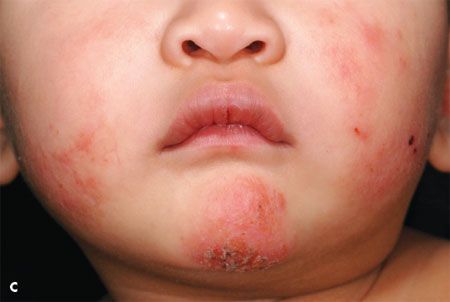What Caused the Facial Rash in These Infants That Resists All Topical Therapies?
A 9-month-old boy has had a pruritic facial rash that has resisted topical therapy. Another9-month-old boy has had a similar rash, with no response to topical therapy. Both infants have the same condition and a family history of atopy.

Case: A 9-month-old boy has had a pruritic facial rash (A and B) that has resisted topical therapy. A topical antifungal, topical antibiotics, and 1% hydrocortisone cream have all failed to clear the eruption. Another 9-month-old boy has had a similar rash (C), with no response to topical therapy. Both infants have the same condition and a family history of atopy.

What is this condition-and can you identify the cause?
Subacute eczema caused by continuous wet-dry environment
on the skin.
The primary morphology of these skin lesions is that of a subacute eczema. The individual plaques show erythema, edema, and lichenification, with exudation and crusting. The infants appear very happy when held by their parents, because they can freely rub their faces against the mother’s or father’s clothing to relieve the itching. My working diagnosis is that of an irritant contact eczema. The cause of the eczematous eruptions is similar for both infants.

The boy shown in Photos A and B likes to put everything, including his hand, in his mouth. This results in a continuous wet-dry environment on his skin that is compounded by his mother’s use of baby wipes to clean his face after meals. The linear plaque on his left cheek correlates with the placement of his fingers when he has his hand in his mouth (B).

The boy shown in Photo C is being breast-fed. Thus, his face is also continuously in a wet-dry environment.
This pattern of repeated wet-dry cycles on skin of infants with increased susceptibility causes these subacute eczematous patches, and the environment needs to change in order for the rashes to respond to treatment. The eczematous patches in these infants are thick because of their chronicity and will require the short-term use of a moderately potent topical corticosteroid. Concomitantly, parents should avoid using soap or detergents and use an emollient liberally, especially when the infants are in situations that will expose the skin to repeated wet-dry cycles. After the inflammatory reaction has settled, the skin barrier will need to be maintained with the use of emollients and the avoidance of irritants.
Recognize & Refer: Hemangiomas in pediatrics
July 17th 2019Contemporary Pediatrics sits down exclusively with Sheila Fallon Friedlander, MD, a professor dermatology and pediatrics, to discuss the one key condition for which she believes community pediatricians should be especially aware-hemangiomas.